10 Clever Vertical Gardening Solutions for Tiny Yards
- Pallet Gardens – Transform wooden pallets into vertical plant displays by securing them to your fence or wall. These upcycled structures provide multiple planting pockets for herbs, succulents, or seasonal flowers while taking up minimal ground space. You can paint the pallet to match your outdoor décor and create a custom look.
- Hanging Gutter Planters – Mount repurposed rain gutters horizontally along fences or walls to create long, narrow planting beds. These metal or plastic channels are perfect for growing shallow-rooted plants like lettuce, strawberries, or trailing flowers, giving you multiple growing rows in the space of one.
- Pocket Shoe Organizers – Repurpose fabric shoe organizers into living walls by filling each pocket with soil and plants. These flexible garden answers can hang on any sturdy surface and accommodate dozens of small plants like herbs, succulents, or small flowering varieties in just a few square feet.
- Trellis Systems – Install decorative trellises against walls to support climbing vegetables and flowering vines. These framework structures guide plants upward rather than outward, perfect for growing cucumbers, beans, peas, morning glories, or clematis in tight spaces.
- Tiered Plant Stands – Use multi-level plant stands to stack potted plants vertically. These space-efficient structures come in various designs from spiral staircases to ladder-style shelving, allowing you to display many plants while maintaining a small footprint.
- Window Box Stacks – Mount multiple window boxes one above the other on walls or fence posts. This cascading arrangement creates a column of greenery that maximizes growing space for herbs, compact vegetables, or cascading flowers like petunias and calibrachoa.
- Vertical Hydroponic Systems – Install self-contained hydroponic towers that grow plants without soil. These modern systems circulate nutrient-rich water through stacked growing pods, allowing you to grow leafy greens, herbs, and compact vegetables year-round while using 90% less water than traditional gardening.
- Hanging Basket Poles – Set up shepherd’s hooks or custom poles that hold multiple hanging baskets at different heights. This arrangement creates a vertical garden column that can be placed anywhere in your yard, perfect for showcasing trailing plants and colorful annuals.
- Living Picture Frames – Create framed succulent displays that hang on walls like artwork. These specialized planters hold soil securely behind mesh while allowing succulent plants to grow outward, turning bare walls into low-maintenance living decorations.
- Bottle Tower Gardens – Construct recycled plastic bottle towers by stacking cut bottles vertically with soil inside. These DIY columns can grow dozens of small plants like strawberries, herbs, or lettuce in a footprint smaller than a dinner plate, making them ideal for tiny corners or balcony edges.
7 Space-Saving Container Gardens for Balconies and Patios
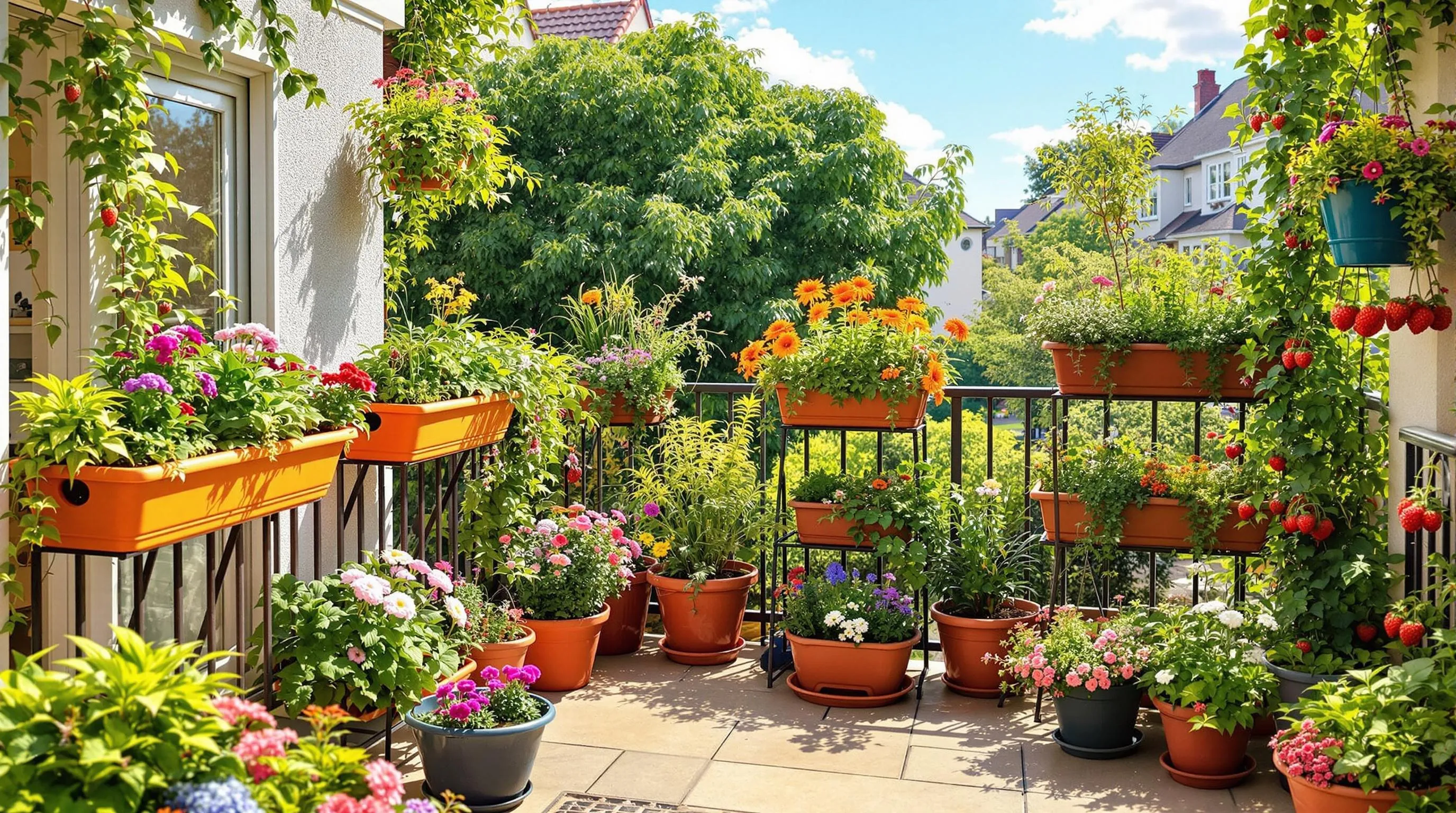
- Railing Planters – Maximize your balcony’s perimeter with railing planters that attach securely to railings without taking up floor space. These narrow containers create a beautiful floral border while leaving your walking area free. Try growing cascading flowers like petunias or practical herbs that you’ll use regularly in cooking.
- Tiered Plant Stands – Make use of vertical space with multi-level plant stands that allow you to display many plants in the footprint of just one or two pots. Modern spiral or ladder-style designs create visual interest while accommodating plants of different light requirements at various heights.
- Hanging Basket Systems – Install ceiling hooks or free-standing hanging basket poles to create a stunning aerial garden. Combine several hanging baskets at different heights for a dramatic effect. Use lightweight coco fiber liners and choose trailing plants like string of pearls, ivy, or strawberries for the best visual impact.
- Wall-Mounted Pocket Planters – Transform empty wall space into a living garden with fabric pocket planters or modular wall systems. These shallow containers work perfectly for herbs, succulents, and small flowering plants while creating a stunning vertical focal point that doubles as garden art.
- Stackable Containers – Invest in specially designed stackable pots that create tower gardens with built-in water reservoirs. These space-efficient systems can grow strawberries, herbs, and flowers in a fraction of the space required by traditional pots, making them perfect for corner placement on tiny balconies.
- Rolling Garden Carts – Choose containers with wheels for flexibility in small spaces. These mobile gardens can be moved to follow the sun or rearranged when entertaining guests. Fill them with seasonal vegetables like cherry tomatoes and peppers for a productive mini garden that can be easily relocated.
- Window Box Clusters – Create depth and visual interest by clustering window boxes not just on railings but also on small tables or crates. Stack them in interesting arrangements, with taller plants in the back and cascading varieties in front for a lush, layered look that maximizes your growing space.
5 Ingenious Hanging Garden Ideas to Maximize Growing Space
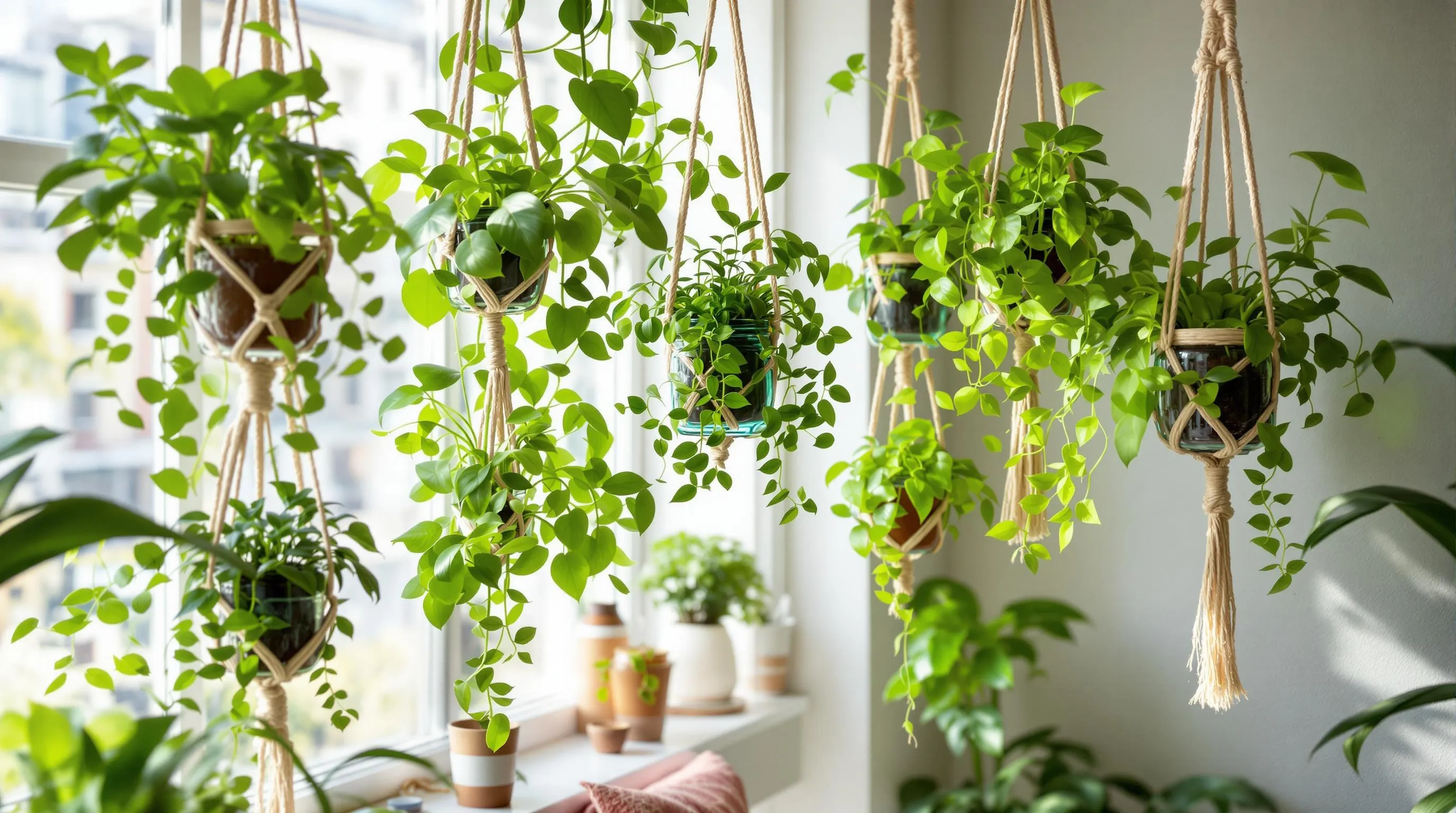
Hanging gardens offer the perfect solution for gardeners with limited floor space. These suspended growing systems use vertical space effectively while adding visual interest to your small garden area.
1. Macramé Plant Hangers
Macramé plant hangers combine style with functionality, making them perfect for small-space gardening. You can create these decorative hangers using inexpensive cotton rope and basic knotting techniques found in online tutorials. Hang them from ceiling hooks, curtain rods, or even sturdy shower curtain rods in bathrooms with adequate light. The beauty of macramé is its adaptability—create shorter designs for small pothos or longer versions for trailing plants like string of pearls.
2. Repurposed Household Items
Transform everyday objects into unique hanging planters to save money and reduce waste. Convert mason jars, tin cans, plastic bottles, or teacups into charming hanging containers by drilling drainage holes and attaching sturdy wire or rope. Old colanders make perfect hanging baskets with built-in drainage. Even wooden crates can be suspended with strong rope to create mini hanging garden beds for herbs and small vegetables.
3. Tiered Hanging Systems
Maximize vertical growing space with multi-level hanging planters that accommodate many plants in a single footprint. Commercial tiered hanging baskets feature 3-5 levels of growing space, perfect for strawberries, herbs, or trailing flowers. For a DIY approach, connect multiple pots vertically using strong chain or rope, ensuring each level receives adequate light. Position these systems near windows or on balconies where the cascading effect creates a stunning visual display.
4. Hanging Gutter Gardens
Repurposed rain gutters create efficient linear hanging gardens ideal for growing shallow-rooted plants. Mount sections of vinyl gutters to walls or fences using strong brackets, ensuring a slight slope for drainage. These systems excel for growing lettuce, spinach, herbs, and strawberries in minimal space. For indoor use, plastic gutters can be suspended from ceiling hooks near bright windows, creating an eye-catching herb garden in kitchens.
5. Hanging Pocket Organizers
Fabric shoe organizers repurposed as vertical gardens offer an affordable way to grow dozens of plants in minimal space. These ready-made pocket systems can hold 20+ plants while occupying just a few square feet of wall space. They work particularly well for herbs, succulents, and small ornamentals. Mount them securely to sturdy walls or hang them from strong hooks or curtain rods. For proper drainage, punch small holes in each pocket’s bottom or line with pebbles before adding soil.
Best Plants for Hanging Gardens
Select plants that thrive in hanging environments to ensure success with your suspended garden. Trailing varieties like pothos, spider plants, and string of pearls create dramatic cascading effects. For edibles, choose compact varieties like cherry tomatoes, strawberries, and herbs including thyme, oregano, and trailing rosemary. Succulents work exceptionally well in hanging gardens due to their low water requirements and varied textures. Flowering options like petunias, calibrachoa, and lobelia add vibrant color while spilling over container edges. When selecting plants, consider weight limitations of your hanging system and match plant needs to available light conditions in your space.
8 Window Box and Windowsill Garden Inspiration
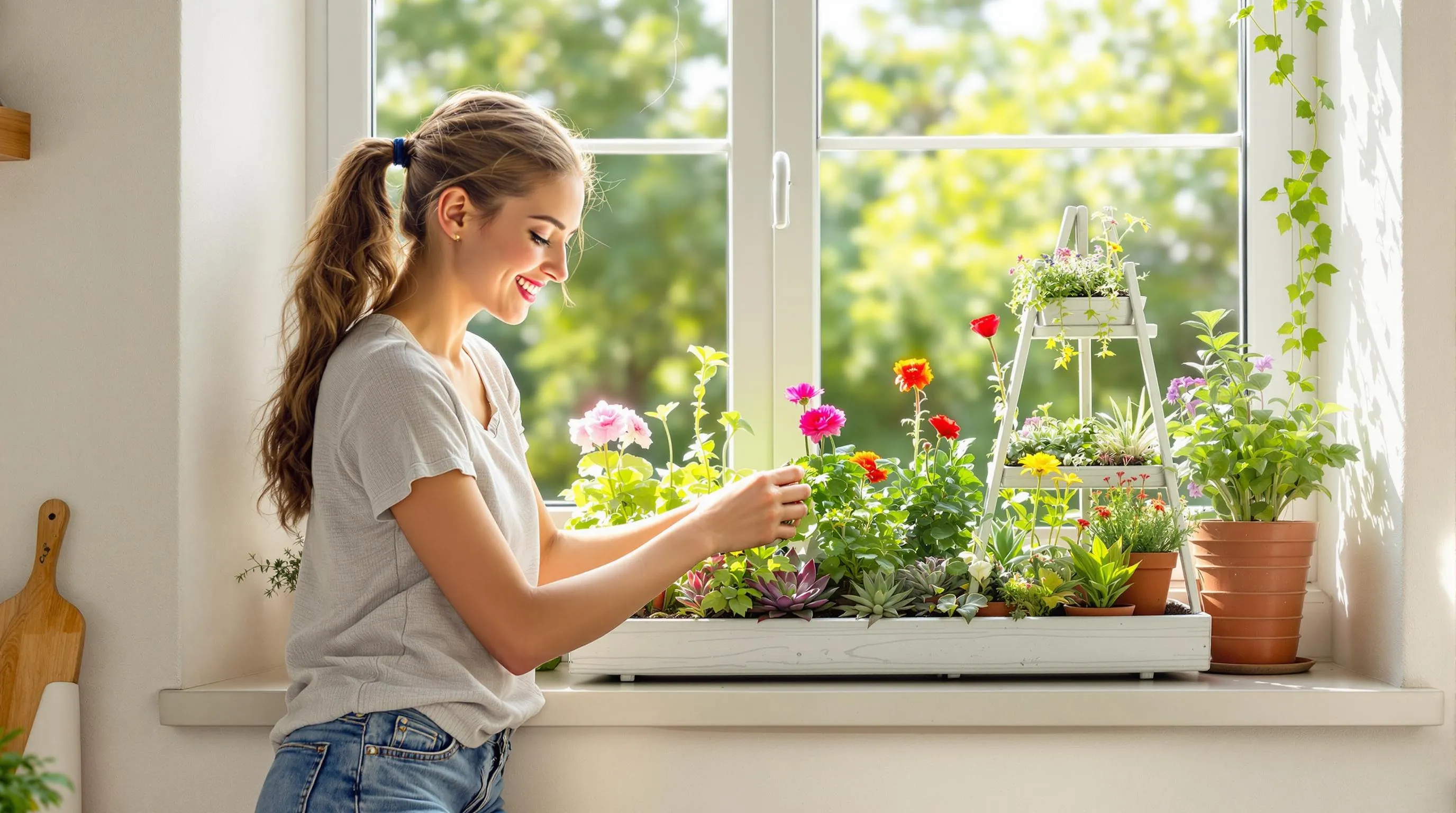
1. Herb-Focused Window Boxes
Transform your kitchen window into a functional herb garden with a simple window box. Plant basil, thyme, mint, and rosemary for easy access while cooking. These herbs thrive in sunny windowsills and provide both fragrance and flavor to your meals. Choose a box with proper drainage and consider self-watering designs if you’re often busy.
2. Cascading Flower Displays
Create visual drama with cascading flowers that spill over your window box edges. Plants like lobelia, petunias, and sweet alyssum will create a waterfall effect of blooms. Combine these with upright flowers like geraniums or marigolds for dimension and structure that catches the eye from both inside and outside your home.
3. Succulent Window Gardens
Design a low-maintenance windowsill garden with an arrangement of colorful succulents. These drought-tolerant plants require minimal watering and care while adding architectural interest to your space. Mix varieties like echeverias, sedums, and haworthias for different textures and colors that thrive in bright, indirect light.
4. Indoor Salad Bars
Grow your own salad ingredients in sunny window boxes with compact lettuce varieties, cherry tomatoes, and radishes. These fast-growing edibles can provide fresh harvests year-round with proper care. Plant cut-and-come-again lettuce varieties that regrow after harvesting for continuous yields from limited space.
5. Seasonal Window Displays
Rotate your window box plantings with the seasons to maintain year-round interest. Switch from spring bulbs to summer annuals, fall chrysanthemums, and winter evergreens with berries. This approach keeps your window gardens looking fresh while allowing you to experiment with different plant combinations throughout the year.
6. Vertical Window Frame Gardens
Install a window-framing trellis system for climbing plants that extends your gardening space upward. Grow sweet peas, morning glories, or climbing nasturtiums that can climb around your window while leaving the sill free for additional planters. This creates a living frame that adds privacy while maximizing your growing potential.
7. Upcycled Container Collections
Arrange mismatched containers like tea tins, mason jars, and vintage cups along your windowsill for an eclectic garden display. These small containers are perfect for individual herb plants or small flowering specimens. Ensure proper drainage by adding pebbles at the bottom of containers without holes.
8. Double-Decker Window Systems
Maximize your window space with tiered plant shelving that creates multiple growing levels. Install clear acrylic shelves that allow light to penetrate to lower levels while doubling or tripling your growing area. This approach works especially well for propagating plants and starting seedlings in limited space.
6 Creative Raised Bed Designs for Limited Garden Space
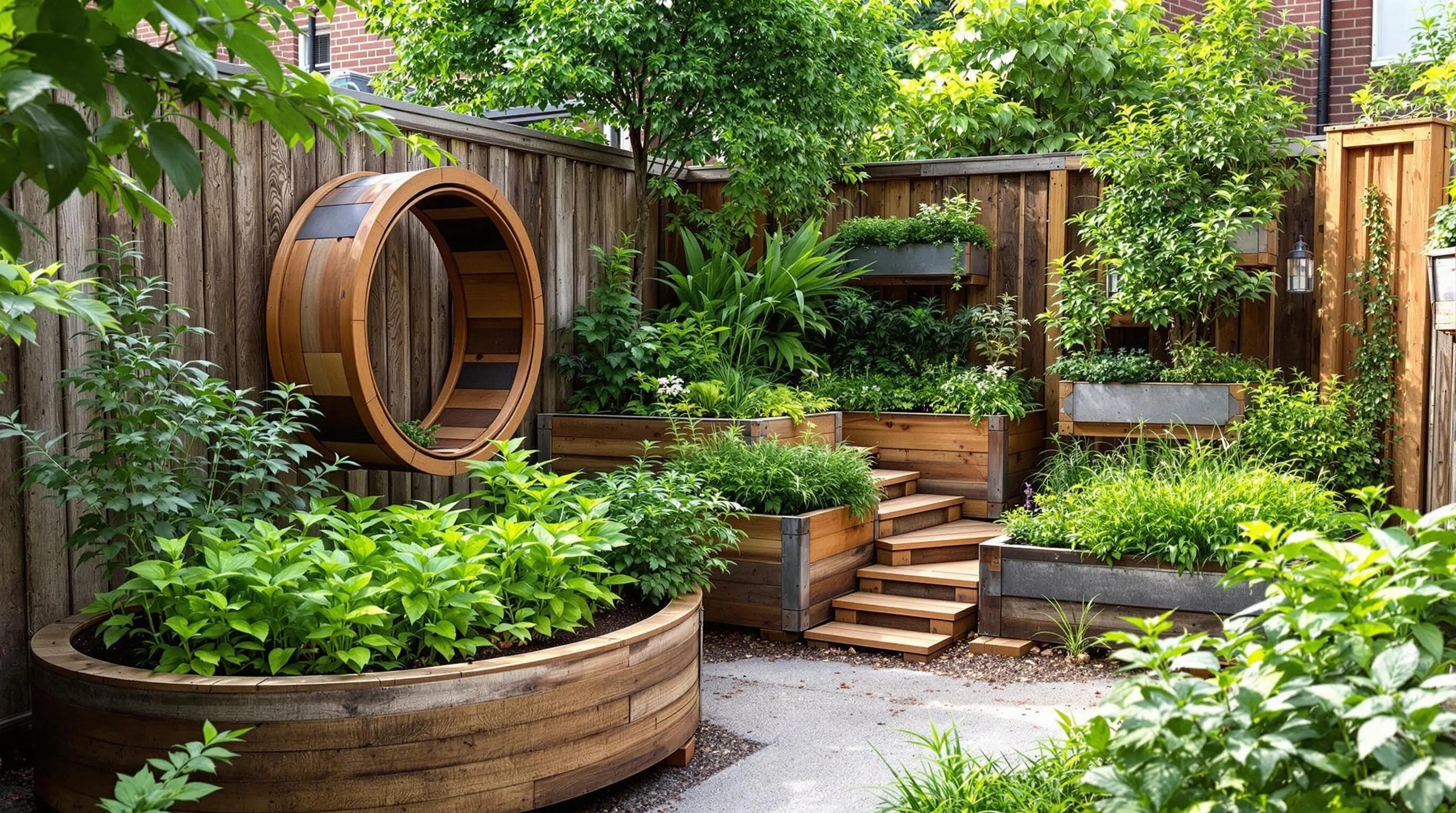
Even the smallest outdoor areas can accommodate productive gardens with the right raised bed design. These elevated growing spaces not only maximize your limited square footage but also improve soil quality and drainage while reducing back strain during gardening tasks.
Space-Efficient Raised Bed Layouts
Keyhole garden beds create a circular design with a central access point, allowing you to reach all plants without stepping on soil. These space-saving structures typically measure 6 feet in diameter with a narrow pathway extending to the center, maximizing growing space while minimizing the footprint. Tiered or cascading beds use vertical space by creating multiple growing levels in a single footprint—perfect for sloped areas or against walls. Spiral herb gardens form an ascending spiral shape that creates many micro-climates for different herbs while using minimal ground space. Corner L-shaped beds transform unused corner spaces into productive growing areas, fitting snugly against fences or walls. Puzzle-piece modular beds can be arranged in various configurations to adapt to your exact space constraints, allowing for easy expansion or reconfiguration as needed. Pyramid beds start wide at the base and narrow toward the top, creating multiple planting surfaces in a compact footprint—ideal for strawberries, herbs, and shallow-rooted vegetables.
Materials to Consider for Urban Raised Beds
Reclaimed wooden pallets offer an affordable, sustainable option that can be disassembled and reconstructed into custom-sized beds. Cedar and redwood provide natural rot resistance without chemical treatments, lasting 10-15 years in most climates. Galvanized metal stock tanks and corrugated panels create modern, long-lasting beds that heat up quickly in spring—perfect for urban settings. Concrete blocks can be arranged in many configurations without fasteners and include holes for additional planting pockets. Fabric grow bags and containers provide ultimate flexibility, allowing you to create “soft” raised beds that can be moved or reconfigured seasonally. Composite lumber made from recycled plastic and wood fibers offers durability without maintenance, though at a higher initial cost. For ultra-urban settings, consider repurposed items like old bathtubs, wheelbarrows, or industrial containers that add character while serving as functional growing spaces.
9 Indoor Gardening Ideas When Outdoor Space Is Scarce
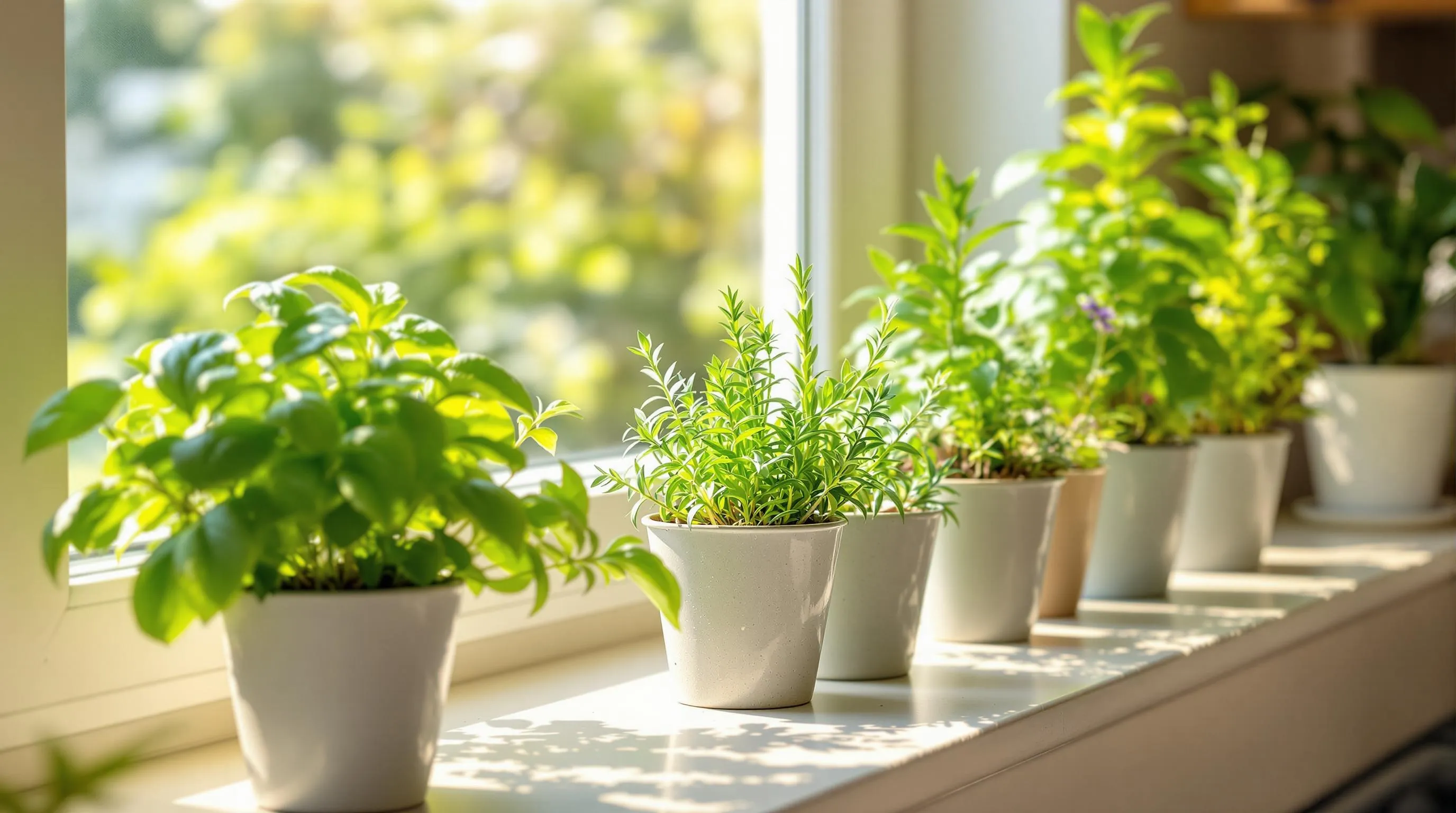
No outdoor space? No problem! Indoor gardening offers a perfect solution for urban dwellers and apartment residents looking to grow plants without access to yards or balconies. These indoor options allow you to enjoy the benefits of gardening regardless of your living situation.
1. Windowsill Herb Gardens
Transform your kitchen windowsill into a productive herb garden that’s both practical and beautiful. Plant basil, chives, mint, and rosemary in small containers with drainage holes to ensure they thrive. Position them in a south-facing window for maximum sunlight exposure, and you’ll have fresh herbs at your fingertips year-round for cooking. Harvest regularly to encourage bushier growth and rotate the pots occasionally for even growth.
2. Countertop Microgreens
Grow nutrient-dense microgreens on any kitchen counter using shallow trays just 2-3 inches deep. These fast-growing crops like radish, sunflower, and pea shoots can be harvested within 7-14 days. Simply spread seeds over moist growing medium, cover until germination, then expose to light. Microgreens require minimal space yet deliver intense flavors and nutritional benefits to your meals.
3. Vertical Wall Planters
Install modular wall planters to create a living wall that maximizes vertical space. Choose pocket-style planters or mounted containers that can hold multiple plants without taking up floor space. Perfect for growing trailing pothos, spider plants, ferns, or even strawberries. Place these near windows or supplement with grow lights for plants further from natural light sources.
4. Kitchen Scrap Regrowth
Regrow vegetables from kitchen scraps on your windowsill using just water and small containers. Green onions, lettuce, celery, and bok choy bases will sprout new growth when placed in shallow water. Change the water every few days to prevent bacteria growth and watch as new plants emerge, providing a continuous harvest and reducing food waste.
5. Under-Cabinet Grow Light Systems
Use the space beneath kitchen cabinets by installing LED grow light strips for herbs and small vegetables. These systems allow you to grow light-loving plants even in kitchens with limited natural light. Choose full-spectrum LEDs that provide the optimal light wavelengths for plant growth and set them on timers for 12-16 hours daily.
6. Bathroom Tropical Gardens
Harness the naturally humid environment of your bathroom to create a tropical oasis with moisture-loving plants. Ferns, peace lilies, and orchids thrive in this environment with minimal care. Place them near shower windows or supplement with grow lights if natural light is insufficient. The steam from your shower provides perfect humidity levels for these tropical beauties.
7. Bookshelf Plant Displays
Convert portions of your bookshelf into dedicated plant space by arranging small potted plants among your books and decorative items. Choose plants with varied heights and textures for visual interest. Snake plants, ZZ plants, and pothos work well in these lower-light conditions and add a living element to your shelving displays.
8. Miniature Indoor Greenhouse Systems
Create self-contained growing environments using tabletop greenhouse systems or terrariums. These enclosed systems maintain higher humidity levels for sensitive plants and can house multiple specimens in a small footprint. Perfect for growing carnivorous plants, air plants, or tropical miniatures that require exact environmental conditions.
9. Smart Indoor Garden Systems
Invest in automated hydroponic systems designed specifically for indoor use that take up less than 1 square foot of counter space. These all-in-one units feature built-in lighting, automated watering, and nutrient delivery systems that make growing foolproof even for beginners. Many models can grow up to 9 plants simultaneously, allowing you to cultivate herbs, lettuce, or cherry tomatoes with minimal maintenance.
4 Micro-Gardening Techniques Using Recycled Materials
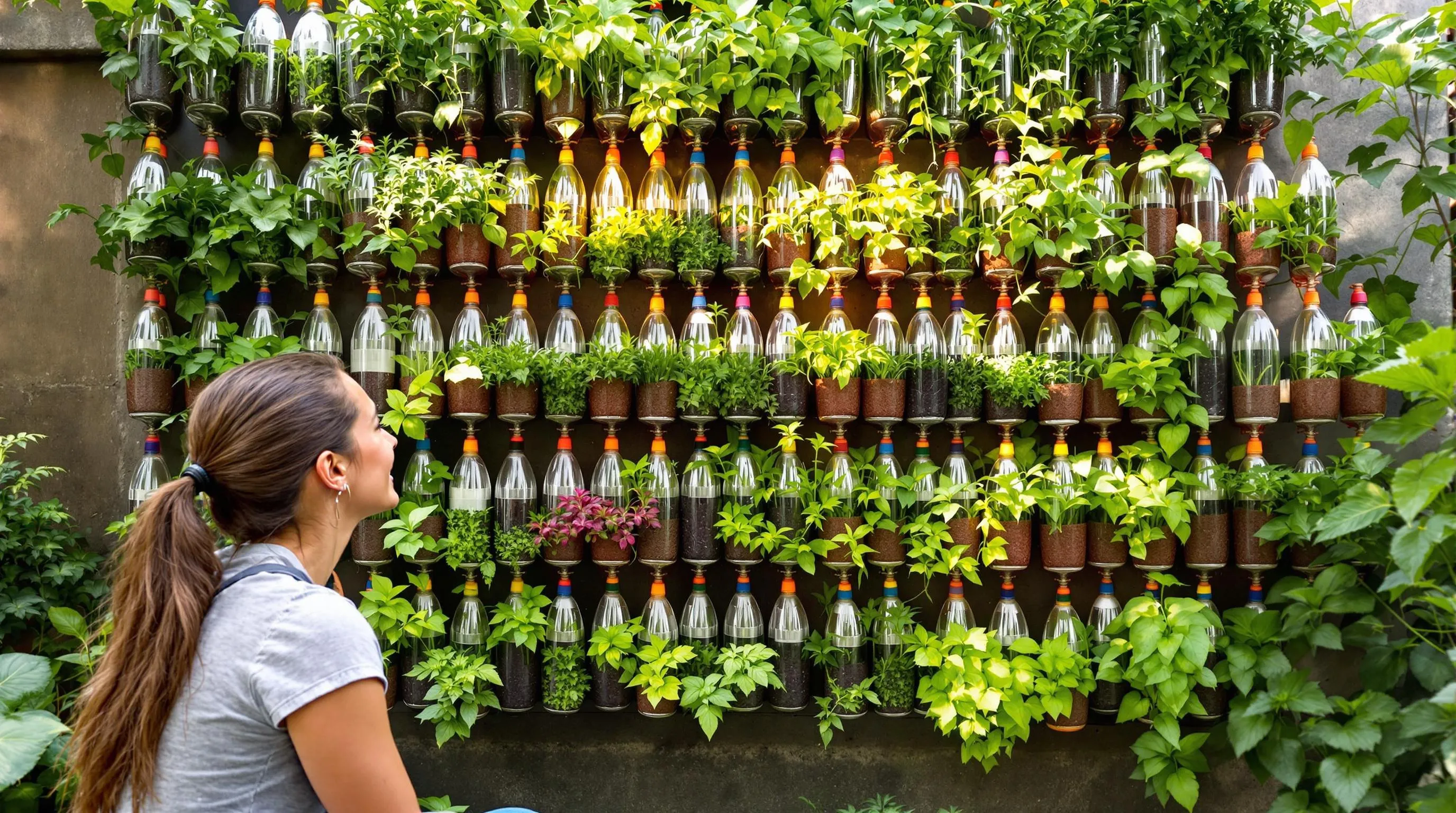
1. Plastic Bottle Vertical Gardens
Transform empty plastic bottles into hanging or wall-mounted planters for an eco-friendly vertical garden. Cut a rectangular opening in the side of a clean 2-liter bottle, drill drainage holes in the bottom, and fill with lightweight potting mix. These bottle planters work perfectly for herbs like basil, mint, and chives or small flowering plants such as pansies and violas. Mount them on walls using strong twine or wire through holes punched near the bottle cap, creating a cascading effect when multiple bottles are arranged vertically. You’ll reduce plastic waste while maximizing growing space in even the tiniest areas.
2. Tin Can Herb Containers
Repurpose empty food cans into charming herb containers that fit perfectly on windowsills or compact shelving. Clean cans thoroughly, punch drainage holes in the bottom using a nail and hammer, and decorate with weather-resistant paint or fabric wraps. These upcycled planters are ideal for shallow-rooted herbs like thyme, oregano, and cilantro. Group different-sized cans together to create a visually interesting mini herb garden that requires minimal space. You’ll enjoy fresh herbs for cooking while giving new life to items that would otherwise end up in landfills.
3. Egg Carton Seedling Starters
Start your garden journey with egg cartons as biodegradable seedling starters that maximize limited counter space. Cut apart cardboard egg cartons, poke small drainage holes in each cup, and fill with seed-starting mix. These compact containers are perfect for starting lettuce, spinach, and annual flower seeds. Place filled cartons on trays near a sunny window or under grow lights. When seedlings develop their first true leaves, plant the entire cup directly into larger containers—the cardboard will decompose naturally. You’ll save money on plastic nursery pots while efficiently starting dozens of plants in a space no larger than a laptop.
4. Pallet Planter Walls
Convert wooden pallets into space-saving vertical planters that transform blank walls into productive growing spaces. Clean a pallet thoroughly, attach industry fabric to the back and bottom using a staple gun, and fill the spaces between slats with quality potting soil. These vertical structures accommodate many plants in a footprint measuring just a few inches deep. Plant strawberries, lettuces, succulents, or cascading flowers like lobelia in each row. Mount the completed pallet garden securely on a sunny wall or fence. You’ll create an impressive living wall that produces food or flowers while taking up virtually no floor space.
5 Space-Maximizing Herb Garden Ideas for Kitchens

1. Magnetic Herb Planters
Magnetic herb planters transform unused refrigerator or metal cabinet space into functional herb gardens. These small containers attach directly to metal surfaces with built-in magnets, creating an accessible herb display without taking up counter space. Choose compact herbs like thyme, oregano, and chives that thrive in these smaller containers. The proximity to your cooking area ensures fresh herbs are always within reach while making creative use of vertical kitchen space that’s typically overlooked.
2. Under-Cabinet Hanging Jars
Maximize the dead space beneath your kitchen cabinets by installing hanging herb jars. Mount small mason jars or repurposed containers to the underside of cabinets using brackets or specially designed hangers. This system keeps herbs visible and accessible while freeing up valuable counter and windowsill space. Perfect for basil, mint, and cilantro, these hanging gardens create visual interest while ensuring your most-used culinary herbs are within arm’s reach during meal preparation.
3. Tiered Countertop Herb Stands
Tiered herb stands multiply your growing space by stacking plants vertically rather than spreading them horizontally. These multi-level planters can host 6-10 different herbs while occupying the footprint of just one or two traditional pots. Position your tiered stand near a kitchen window for optimal light exposure. The cascading design not only saves space but creates an attractive focal point, turning your herb garden into a decorative kitchen feature while keeping fresh ingredients handy.
4. Window-Mounted Herb Shelves
Window-mounted herb shelves make the most of natural light without sacrificing windowsill space. These transparent acrylic or glass shelves attach directly to your window with suction cups or brackets, creating floating gardens that capture maximum sunlight. The design allows light to pass through to plants on lower shelves and into your kitchen. These systems accommodate up to 6 different herbs while keeping them organized and visible, turning your window into productive growing space.
5. Hanging Colander Planters
Repurpose old colanders into hanging herb gardens that combine rustic charm with practical function. The built-in drainage makes colanders perfect planters, while hanging them from ceiling hooks or curtain rods utilizes overhead space that would otherwise go unused. Group several colanders at different heights for a dramatic display that can hold 4-5 different herbs. This solution works particularly well for trailing herbs like creeping thyme or oregano and creates a unique decorative element that enhances your kitchen’s character.
7 Seasonal Planning Tips for Small Space Gardens

1. Create a Yearly Calendar
Map out your garden’s entire year in advance using a dedicated calendar. Mark important dates like last frost, first frost, seed starting times, and harvest periods. This visual roadmap helps you maximize your small space by planning succession planting, where new crops replace harvested ones, ensuring continuous production throughout the growing season.
2. Practice Succession Planting
Make the most of limited square footage by planning sequential harvests. As soon as you harvest cool-season crops like lettuce or peas in early summer, immediately replant with warm-season vegetables like bush beans or cucumbers. This technique can double or triple your small garden’s productivity without expanding its footprint.
3. Choose Multi-Season Plants
Select plants that provide value across multiple seasons in your small garden. Dwarf fruit trees offer spring blossoms, summer shade, autumn fruit, and winter structure. Compact berry bushes like ‘Top Hat’ blueberry produce spring flowers, summer fruit, and brilliant fall foliage, delivering three-season interest in just one square foot.
4. Carry out Vertical Rotation
Apply crop rotation principles vertically in your small garden by changing what grows on trellises, walls, and hanging systems each season. This prevents pest buildup and nutrient depletion while maintaining your space-saving vertical strategy. Simply assign different plant families to different vertical zones each year.
5. Create Microclimates
Strategically position containers and raised beds to take advantage of seasonal light changes. South-facing walls provide winter warmth for cold-sensitive plants, while east-facing areas offer summer shade during hot afternoons. This microclimate awareness lets you grow a wider variety of plants in your limited space throughout the year.
6. Maintain a Seasonal Seed Bank
Organize a compact seed storage system with seeds grouped by planting season rather than plant type. This approach ensures you’ll always have appropriate options ready for immediate planting when space becomes available, eliminating decision delays that waste precious growing time in small gardens.
7. Develop Season-Extension Strategies
Extend your growing season with portable covers and protection systems sized specifically for small spaces. Collapsible cold frames, pop-up cloches, and fabric row covers can protect plants from unexpected frosts or extend harvest periods by weeks. These temporary structures can be easily stored when not needed, making them perfect for limited space gardens.
Transforming Your Small Space: From Barren to Bountiful
Small-space gardening isn’t about limitations but possibilities. With vertical systems hanging planters containers and raised beds you can create a thriving garden in even the tiniest areas.
Remember that walls windows railings and indoor spaces all offer growing potential. By thinking upward rather than outward you’ll maximize every inch while creating a visually stunning display.
The beauty of small-space gardening lies in its accessibility. You don’t need acres of land or expensive equipment to nurture plants that bring joy beauty and even food to your daily life. Start with one small project then watch as your gardening confidence and green space grow together.





